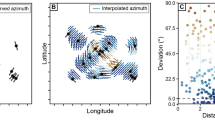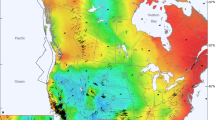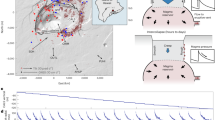Abstract
Knowledge of the state of stress in Earth’s crust is key to understanding the forces and processes responsible for earthquakes. Historically, low rates of natural seismicity in the central and eastern United States have complicated efforts to understand intraplate stress, but recent improvements in seismic networks and the spread of human-induced seismicity have greatly improved data coverage. Here, we compile a nationwide stress map based on formal inversions of focal mechanisms that challenges the idea that deformation in continental interiors is driven primarily by broad, uniform stress fields derived from distant plate boundaries. Despite plate-boundary compression, extension dominates roughly half of the continent, and second-order forces related to lithospheric structure appear to control extension directions. We also show that the states of stress in several active eastern United States seismic zones differ significantly from those of surrounding areas and that these anomalies cannot be explained by transient processes, suggesting that earthquakes are focused by persistent, locally derived sources of stress. Such spatially variable intraplate stress appears to justify the current, spatially variable estimates of seismic hazard. Future work to quantify sources of stress, stressing-rate magnitudes and their relationship with strain and earthquake rates could allow prospective mapping of intraplate hazard.
This is a preview of subscription content, access via your institution
Access options
Access Nature and 54 other Nature Portfolio journals
Get Nature+, our best-value online-access subscription
$29.99 / 30 days
cancel any time
Subscribe to this journal
Receive 12 print issues and online access
$259.00 per year
only $21.58 per issue
Buy this article
- Purchase on Springer Link
- Instant access to full article PDF
Prices may be subject to local taxes which are calculated during checkout


Similar content being viewed by others
References
Zoback, M. L. & Zoback, M. D. State of stress in the conterminous United States. J. Geophys. Res. 85, 6113–6156 (1980).
Jones, C. H., Unruh, J. R. & Sonder, L. J. The role of gravitational potential energy in active deformation in the southwestern United States. Nature 381, 37–41 (1996).
Flesch, L. M., Holt, W. E., Haines, A. J. & Shen-Tu, B. Dynamics of the Pacific–North American plate boundary in the western United States. Science 287, 834–836 (2000).
Zoback, M. L. Stress field constraints on intraplate seismicity in eastern North America. J. Geophys. Res. 97, 11761–11782 (1992).
Reiter, K. et al. A revised crustal stress orientation database for Canada. Tectonophysics 636, 111–124 (2014).
Stein, S. & Liu, M. Long aftershock sequences within continents and implications for earthquake hazard assessment. Nature 462, 87–89 (2009).
Ellsworth, W. L. Injection-induced earthquakes. Science 341, 1225942 (2013).
Weingarten, M. et al. High-rate injection is associate with the increase in U.S. midcontinent seismicity. Science 348, 1336–1340 (2015).
Heidbach et al. World Stress Map Database 2016 (GFZ, 2016); https://doi.org/10.5880/WSM.2016.001
England, P., Houseman, G. & Sonder, L. J. Lengthscales for continental deformation in convergent, divergent and strike-slip environments. J. Geophys. Res. 90, 3551–3557 (1985).
Silver, P. G. & Holt, W. E. The mantle flow field beneath western North America. Science 295, 1054–1057 (2002).
Humphreys, E. D. & Coblentz, D. North American dynamics and western U.S. tectonics. Rev. Geophys. 45, RG3001 (2007).
Ghosh, A. & Holt, W. E. Plate motions and stresses from global dynamic models. Science 335, 838–843 (2012).
Hurd, O. & Zoback, M. D. Intraplate earthquakes, regional stress, and fault mechanics in the central and eastern U.S. and southeastern Canada. Tectonophysics 581, 182–192 (2012).
Lund-Snee, J. E. & Zoback, M. D. State of stress in Texas: implications for induced seismicity. Geophys. Res. Lett. 43, 10208–10214 (2016).
Simpson, R. W. Quantifying Anderson’s fault types. J. Geophys. Res. 102, 17909–17919 (1997).
Zoback, M. L. & Zoback, M. D. Tectonic stress field of the continental United States. GSA Memoir 172, 523–540 (1989).
Gough, D. I., Fordjor, C. K. & Bell, J. S. A stress province boundary and tractions on the North American plate. Nature 305, 619–621 (1983).
Becker, T. W. et al. Western US intermountain seismicity caused by changes in upper mantle flow. Nature 524, 458–461 (2015).
Hurd, O. & Zoback, M. D. Regional stress orientations and slip compatibility of focal mechanisms in the New Madrid Seismic Zone. Seismol. Res. Lett. 83, 672–679 (2012).
Petersen, M.D. et al. Documentation of the 2014 Update of the United States National Seismic Hazard Maps USGS Open File Report 1091 (USGS, 2014).
Calais, E. et al. Triggering of New Madrid seismicity by late-Pleistocene erosion. Nature 466, 608–611 (2010).
Stein, R. The role of stress transfer in earthquake occurrence. Nature 402, 605–609 (1999).
Wesson, R. L. & Boyd, O. S. Stress before and after the 2002 Denali Fault earthquake. Geophys. Res. Lett. 34, L07303 (2007).
Mueller, K., Hough, S. E. & Bilham, R. Analysing the 1811–1812 New Madrid earthquakes with recent instrumentally recorded aftershocks. Nature 429, 284–287 (2004).
Lowry, A. R. & Pérez-Gussinyé, M. The role of crustal quartz in controlling Cordilleran deformation. Nature 471, 353–357 (2011).
Zoback, M. D. & Townend, J. Implications of hydrostatic pore pressures and high crustal strength for the deformation of continental lithosphere. Tectonophysics 336, 19–30 (2001).
Sonder, L. J. Effects of density contrasts on the orientation of stresses in the lithosphere: relation to principal stress directions in the Transverse Ranges, California. Tectonics 9, 761–771 (1990).
Forte, A. M. et al. Descent of the ancient Farallon slab drives localized mantle flow beneath the New Madrid seismic zone. Geophys. Res. Lett. 34, L04308 (2007).
Zoback, M. L. & Richardson, R. M. Stress perturbation associated with the Amazonas and other ancient rifts. J. Geophys. Res. 101, 5459–5475 (1996).
Grana, J. P. & Richardson, R. M. Tectonic stress within the New Madrid seismic zone. J. Geophys. Res. 101, 5445–5458 (1996).
Levandowski, W., Boyd, O. S. & Ramirez-Guzmán, L. Dense lower crust elevates long-term earthquake rates in the New Madrid seismic zone. Geophys. Res. Lett. 43, 8499–8510 (2016).
Biryol, C. B. et al. Relationship between observed upper mantle structure and recent tectonic activity across the southeastern United States. J. Geophys. Res. 121, 3393–3414 (2016).
Shen, W. & Ritzwoller, M. H. Crustal and uppermost mantle structure beneath the United States. J. Geophys. Res. 121, 4306–4342 (2016).
Graw, J. H., Powell, C. A. & Langston, C. A. Crustal and upper mantle velocity structure in the vicinity of the Eastern Tennessee seismic zone based upon radial P-wave transfer functions. J. Geophys. Res. 120, 243–258 (2015).
Cooley, M. T. A New Set of Focal Mechanisms and a Geodynamic Model for the Eastern Tennessee Seismic Zone. MSc thesis, Univ. Memphis (2014).
Wallace, R. E. Geometry of shearing stresses and relation to faulting. J. Geol. 59, 118–130 (1951).
Bott, M. H. P. The mechanics of oblique-slip faulting. Geol. Mag. 96, 109–117 (1959).
Varryčuk, V. Iterative joint inversion for stress and fault orientations from focal mechanisms. Geophys. J. Int. 199, 69–77 (2014).
Herrmann, R. B. Moment Tensors for North America (St Louis Univ. accessed 1 January 2018); http://www.eas.slu.edu/eqc/eqc_mt/MECH.NA/MECHFIG/mech.html
Herrmann, R. B., Malagnini, L. & Munafó, I. Regional moment tensors of the 2009 L’Aquila earthquake sequence. Bull. Seismol. Soc. Am. 101, 975–993 (2011).
Wu, Q., Chapman, M. C. & Beale, J. N. The aftershock sequence of the 2011 Mineral, Virginia earthquake: temporal and spatial distribution, focal mechanisms, regional stress, and the role of Coulomb stress transfer. Bull. Seismol. Soc. Am. 105, 2521–2527 (2015).
Johnson, G. A., Horton, S. P., Withers, M. & Cox, R. Earthquake focal mechanisms in the New Madrid seismic zone. Seismol. Res. Lett. 85, 257–267 (2014).
Walsh, F. R.III & Zoback, M. D. Probabilistic assessment of potential fault slip related to injection-induced earthquakes: application to north-central Oklahoma, USA. Geology 44, 991–994 (2016).
Chapman, M. C. et al. A statistical analysis of earthquake focal mechanisms and epicenter locations in the Eastern Tennessee Seismic Zone. Bull. Seismol. Soc. Am. 87, 1522–1536 (1997).
Martinez-Garzón, P. J. et al. Sensitivity of stress inversion of focal mechanisms to pore pressure changes. Geophys. Res. Lett. 43, 8441–8450 (2016).
Haeussler, P. J. et al. Surface rupture and slip distribution of the Denali and Totschunda faults in the 3 Novermber 2002 M7.9 earthquake, Alaska. Bull. Seismol. Soc. Am. 94, S23–S52 (2004).
Hreinsd¢ttir, S. et al. Coseismic deformation of the 2002 Denali fault earthquake: insights from GPS measurements. J. Geophys. Res. 111, B03308 (2006).
Chapman, M. C. et al. Modern seismicity and the fault responsible for the 1886 Charleston, South Carolina, earthquake. Bull. Seismol. Soc. Am. 106, 364–372 (2016).
Acknowledgements
J. Hardebeck, M. Zoback and M. L. Zoback provided helpful comments and discussions during preparation of this manuscript. W.L. was funded by the USGS Mendenhall Postdoctoral Fellowship and Earthquake Hazards Program.
Author information
Authors and Affiliations
Contributions
W.L. managed catalogue compilation, stress inversions, figure generation and manuscript preparation. R.B.H. generated a plurality of the focal mechanisms and aided in the uncertainty analysis for individual data. All authors collaborated on figure generation, drafting and hypothesis testing.
Corresponding author
Ethics declarations
Competing interests
The authors declare no competing interests.
Additional information
Publisher's note: Springer Nature remains neutral with regard to jurisdictional claims in published maps and institutional affiliations.
Supplementary information
Supplementary Information
Supplementary description, figures, tables, and README file
Supplementary Dataset 1
Focal mechanism database
Supplementary Dataset 2
Results shown in Fig. 2c
Rights and permissions
About this article
Cite this article
Levandowski, W., Herrmann, R.B., Briggs, R. et al. An updated stress map of the continental United States reveals heterogeneous intraplate stress. Nature Geosci 11, 433–437 (2018). https://doi.org/10.1038/s41561-018-0120-x
Received:
Accepted:
Published:
Issue Date:
DOI: https://doi.org/10.1038/s41561-018-0120-x
This article is cited by
-
Complex rupture dynamics of the extremely shallow August 2020 M5.1 Sparta, North Carolina earthquake
Communications Earth & Environment (2024)
-
Multiscale variations of the crustal stress field throughout North America
Nature Communications (2020)
-
A note on stress rotations due to the 2004 Mw 9.2 Sumatra–Andaman megathrust earthquake
Journal of Earth System Science (2020)



